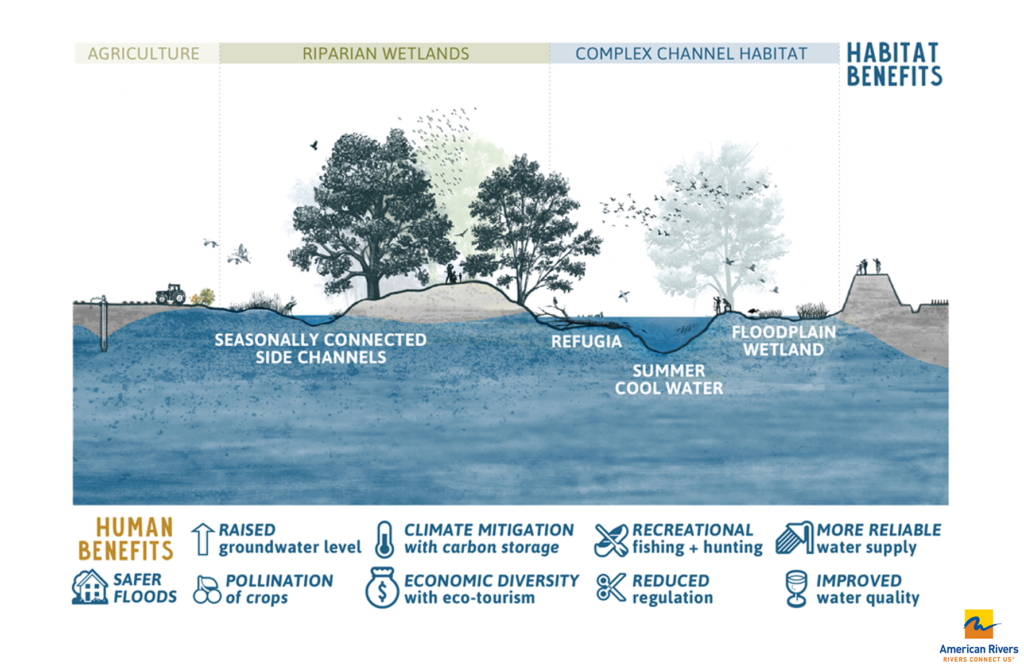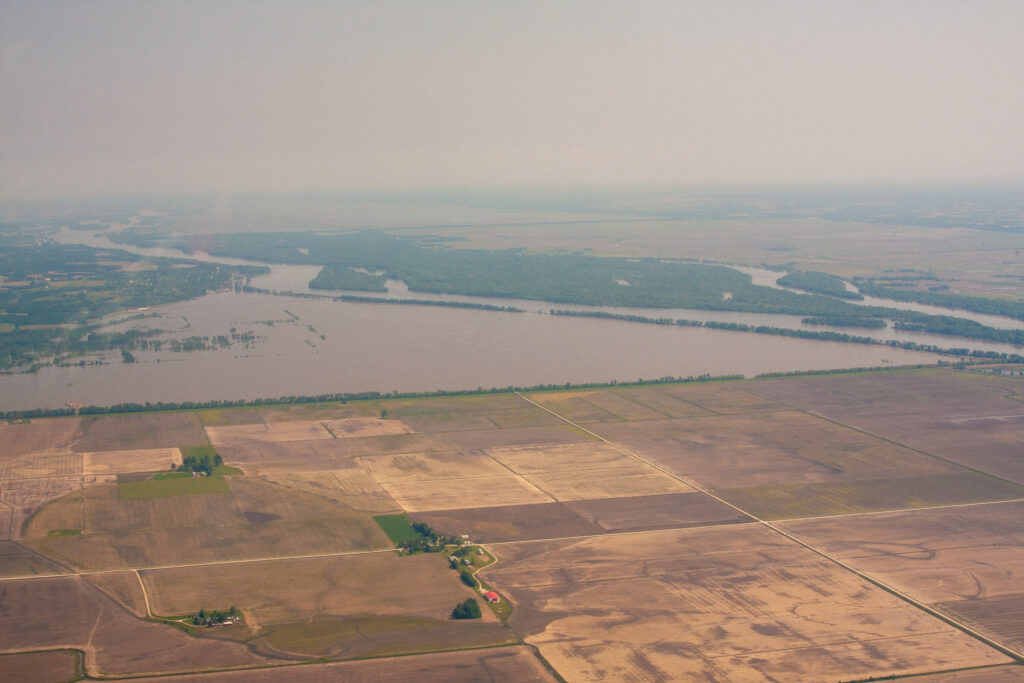Illinois Floodplains Work: A Feasibility Study

Flood-related threats to health, safety and property are among the most pressing climate change issues in Illinois. Unfortunately, actions to reduce flood risk are not keeping pace with the need to protect people, infrastructure and economies. To build more resilient communities in Illinois, we need a new approach.
To accommodate the predicted increase in precipitation, midwestern rivers need more capacity. The changes in land use for expanding flood zones in Illinois can be opportunities to address long-standing racial justice issues and improve biodiversity within the state. “Multi-benefit floodplain development” offers a framework for people living in river communities to address climate disruption, social and racial injustice and biodiversity loss in a holistic way.

What are the barriers?
Where climate change threatens our communities, we already have the technology and know-how to build safer communities, revive our economies and integrate our society to improve the overall quality of life. In Illinois, the main barriers to adopting multi-benefit floodplain development projects are:
- Lack of Community-Led Problem Solving: A community’s needs are dependent on unique conditions found within it, such as culture, social structure, history and assets, to name a few. Therefore, people living within a community are most equipped to speak to these needs. Illinois’ elected officials and state agency staff need to work with community members, municipal staff and non-governmental organizations to establish a better framework to support community-led problem-solving that is tailored to that community’s individual needs. This includes providing more access to information, better venues for collaboration and access to decision-makers.
- Too Few Hazard Mitigation Projects: The number of flood hazard mitigation projects needs to dramatically increase throughout the state. This cannot be limited to only green or gray infrastructure. It will require a combination of the two strategies to build sustainable projects. To support these projects, Illinois General Assembly needs to take deliberate steps to grow the hazard mitigation field of practice, especially in a multi-benefit floodplain management context, and encourage recruitment in this field.
- Economic Instability: Under the current federal and state programs, the local tax base is responsible for paying a significant portion of hazard mitigation costs, especially upfront costs like staffing to apply for grants and oversee programs. But even well-resourced communities cannot keep up with increasing flood risk, and poor communities are being left behind entirely. Alternative financing, like administrative grants and low-interest loans, and in-kind support, like technical assistance, need to be dramatically expanded. Municipal staff must also be supported to work on interconnected issues, like affordable housing and community revitalization.
What can we do?
Other states, including Washington, California and Vermont, have established programs to advance multi-benefit floodplain management projects. To best meet Illinois’ fiscal constraints, we recommend a public-private partnership similar to the Washington model. Washington’s program has leveraged $165 million since 2013 for projects. In addition, as FEMA expands grant opportunities for more resilient, non-traditional flood risk reduction projects, investing in multi-benefit floodplain development will leverage more federal dollars.
The recommendations detailed below are grounded in the real-world successes in other states and are tailored to meet Illinois’ needs through stakeholder meetings and Illinois-based case studies.
1- Establish a Multi-Benefit Floodplain Planning and Development Public-Private Partnership
Many communities, especially communities of low-income and communities of color, do not have access to or are not otherwise benefiting from the full suite of flood risk reduction tools and are not adequately represented in community planning and problem-solving for flood risk management. State and federal agency staff often limit community assistance to only those programs administered by their respective agencies and limit communications within the community to only municipal staff and/or elected officials. This creates barriers for individuals, communities and/or neighborhoods that may have under-resourced, uninformed and/or otherwise unstable local governments. To overcome this barrier, there is a need for state agency staff to form stronger bonds with non-profit, private and other non-governmental organizations to better serve communities.
Illinois General Assembly should establish a public-private partnership to support multi-benefit floodplain planning and development that is focused on helping residents, unofficial community leaders, municipal staff and elected officials find safe, just and environmentally sustainable solutions to flood issues. The goal of the partnership will be to accelerate the implementation of climate hazard mitigation projects through multi-benefit floodplain development. This will be accomplished via projects, programs, and other tools that meet needs in the following four areas:
- Community education on flood-related issues and solutions, including flood insurance rate map use and interpretation, flood insurance programs and rates, flood hazard mitigation and floodplain ecosystem services;
- Community visioning processes with a focus on addressing environmental justice issues like racial equity, affordable housing, storm and wastewater infrastructure, transportation, access to healthy food and improved environmental quality;
- Community guidance for accessing appropriate resources and funding opportunities to address flood-related issues, like Silver Jackets Flood Studies, FEMA Building Resilient Infrastructure and Communities (BRIC) grants and other resources; and
- Community support for administrative tasks, like grant writing and project tracking, to build community capacity for multi-benefit floodplain planning and development that maximizes climate change resilience, social justice and ecosystem health.
2- Establish a Multi-Benefit Floodplain Development Fund to Provide Flexible Funding for Planning and Projects.
Floodplains are important landscapes that provide multiple ecosystem services (improved water quality, aquifer recharge, wildlife habitat, etc.) and they need to be managed to sensibly balance community resilience and environmental health. Unfortunately, most programs that support floodplain planning and development are “siloed.” Funding sources for gray infrastructure, green infrastructure and other community needs (housing, economic development) are often disparate – housed in different agencies and offices with limited staff or program cross-over. Green infrastructure programs often prohibit spending on gray infrastructure, limited information is available on how green infrastructure can be incorporated with gray infrastructure projects, and economic development programs rarely consider natural resource or public safety needs. To get the most benefit out of their floodplains, communities need to plan and develop for all these issues and opportunities simultaneously. To do this most effectively, communities need access to flexible funding to maximize public safety, climate resilience and natural resource benefits in their frequently flooded and floodplain areas.
3- Reform agricultural programs to incentivize flood-compatible farming and land conservation practices.
There are over one million acres of farmland in Illinois prone to flooding, and hundreds of thousands of these acres are “protected” by levees. Levees lower crop insurance rates by pushing flooding problems onto other areas – sometimes other farmland and sometimes urban areas. Additionally, vast expansions in tile drainage systems accelerate the movement of water off the land and into rivers and streams, thus contributing to flashier high-water events in some watersheds. As climate change alters precipitation patterns in the region to more frequent and extreme precipitation events, adaptation efforts need to focus on slowing water wherever it falls on the landscape. Slowing water on the landscape creates more predictability in the river systems and gives floodplain managers time to take necessary steps to protect people and infrastructure. As 75 percent of Illinois’ landmass is in agricultural production, the Illinois General Assembly needs to facilitate and create programs, projects and incentives to farmers to slow the movement of water off the landscape. These might include reforming conservation easement programs to enroll more flood-prone acres, incentivizing cropping systems that hold more water in the soil, amending the antiquated Illinois drainage code to align with modern flood risk management goals and standards, and changing the crop insurance program to not penalize farmers who convey water across their lands during flood events. The General Assembly should mandate a report from the Illinois Department of Agriculture, with consultation from the public-private partnership identified in Recommendation #1, to examine farming practices and programs to identify incentives to encourage more widespread adoption of flood-compatible farming and farmland management practices.

4- Ensure Illinois’ State Agencies provide equitable support services across all programs, including higher levels of planning support for communities that are socially and/or economically disadvantaged.
Some communities have more resources than others. Pre-disaster resilience planning and project funding sources always require some type of community investment, like municipal staff to apply for grants, direct match, upfront costs for development concepts, access to various experts, a tax-base for loan repayments, etc. The General Assembly should direct all agencies to provide tiered assistance to ensure communities get equitable access to resources like planning assistance, grants, technical help, etc. Assistance levels should be based on census block data, and communities with populations that meet multiple census thresholds should be prioritized for higher levels of planning assistance, greater access to funding, and more equitable match requirements. Agencies should be held accountable through transparency and reporting requirements in their assistance and grant-making programs.
5- Require flood hazard mitigation training for all insurance agents.
One of the goals of establishing the Multi-Benefit Floodplain Development Program is educating Illinois’ citizens about floodplains and flood risk management. However, when it comes to decisions about hazard mitigation on private properties, most renters and home and business owners turn to their insurance agents. Insurance agents are the primary trusted sources of flood-related information in the general population. Unfortunately, many insurance agents are not adequately trained to provide accurate information about flood insurance, flood risk, or hazard mitigation options. FEMA provides free virtual and in-person classes on these topics for insurance agents. Illinois General Assembly should mandate flood insurance and hazard mitigation training for all homeowners insurance agents.
